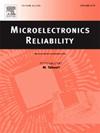先进电子封装用RDL结构中聚酰亚胺/铜的界面断裂行为
IF 1.9
4区 工程技术
Q3 ENGINEERING, ELECTRICAL & ELECTRONIC
引用次数: 0
摘要
聚酰亚胺(PI)由于其优异的机械性能而广泛应用于扇形封装的再分布层(RDL)的制造中。然而,电子元件的小型化对电子制造业提出了许多新的挑战。RDL作为信号重分布和结构支撑的重要组成部分,其结构稳定性评价已成为先进封装领域亟待解决的问题。本研究采用PI/Cu搭接试件,研究了不同固化条件下PI的力学性能和界面粘附性能。通过搭接剪切试验、扫描电镜(SEM)分析和有限元模拟,系统分析了PI在封装结构中的适用性。结果表明:高温烧结的PI具有良好的组织稳定性,在变形过程中不易产生裂纹;但其断裂韧性和强度较低,易从Cu中剥离,不适合大变形的组织。相比之下,室温固化的PI具有更高的断裂强度和更好的界面附着力,以及更大的变形能力,但更容易产生裂纹,因此不适合长期载荷下的结构。本研究不仅揭示了固化条件对PI结构性能和粘附性能的影响机理,而且为先进封装中RDL的制造和PI成型工艺的优化提供了理论支持和研究指导。本文章由计算机程序翻译,如有差异,请以英文原文为准。
Interfacial fracture behavior of polyimide/copper in RDL structures for advanced electronic packaging
Polyimide (PI) is widely used in the fabrication of redistribution layers (RDL) for fan-out packaging due to its excellent mechanical properties. However, the miniaturization of electronic components has posed numerous new challenges to the electronics manufacturing industry. As an important part for signal redistribution and structure support, the evaluation of the structural stability of RDL has become an urgent issue in advanced packaging. In this study, PI/Cu lap joint specimens were used to investigate the mechanical properties and interfacial adhesion performance of PI under different curing conditions. Through lap shear tests, scanning electron microscopy (SEM) analysis, and finite element method (FEM) simulation, the applicability of PI in packaging structures was systematically analyzed. The results show that PI sintered at high temperature exhibits good structural stability and is less prone to crack formation during deformation. But it has relatively low fracture toughness and strength, and tends to delaminate from Cu, making it unsuitable for structures subjected to large deformations. In contrast, PI cured at room temperature demonstrates higher fracture strength and better interfacial adhesion, as well as greater deformability, but is more prone to crack initiation, making it less suitable for structures under long-term loading. This study not only reveals the influence mechanism of curing conditions on the structural properties and adhesion performance of PI, but also provides theoretical support and research guidance for the manufacturing of RDL and the optimization of PI forming processes in advanced packaging.
求助全文
通过发布文献求助,成功后即可免费获取论文全文。
去求助
来源期刊

Microelectronics Reliability
工程技术-工程:电子与电气
CiteScore
3.30
自引率
12.50%
发文量
342
审稿时长
68 days
期刊介绍:
Microelectronics Reliability, is dedicated to disseminating the latest research results and related information on the reliability of microelectronic devices, circuits and systems, from materials, process and manufacturing, to design, testing and operation. The coverage of the journal includes the following topics: measurement, understanding and analysis; evaluation and prediction; modelling and simulation; methodologies and mitigation. Papers which combine reliability with other important areas of microelectronics engineering, such as design, fabrication, integration, testing, and field operation will also be welcome, and practical papers reporting case studies in the field and specific application domains are particularly encouraged.
Most accepted papers will be published as Research Papers, describing significant advances and completed work. Papers reviewing important developing topics of general interest may be accepted for publication as Review Papers. Urgent communications of a more preliminary nature and short reports on completed practical work of current interest may be considered for publication as Research Notes. All contributions are subject to peer review by leading experts in the field.
 求助内容:
求助内容: 应助结果提醒方式:
应助结果提醒方式:


